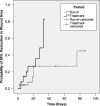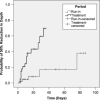Analysis of run-in and treatment data in a wound outcomes registry: clinical impact of topical platelet-rich plasma gel on healing trajectory
- PMID: 21910832
- PMCID: PMC7950678
- DOI: 10.1111/j.1742-481X.2011.00868.x
Analysis of run-in and treatment data in a wound outcomes registry: clinical impact of topical platelet-rich plasma gel on healing trajectory
Abstract
Randomised controlled trials in chronic wounds typically exclude patients with comorbidities and confounding factors. Well-designed observational studies can provide complementary clinical evidence that randomised trials cannot address. This study determined if wound care registry outcomes could be an alternative data source and if the results would be robust and valid. Changes in wound area and depth were hypothesised to be different between run-in therapies and platelet-rich plasma (AutoloGel™, Cytomedix, Inc) treatment. From a treatment registry of 285 chronic wounds, 46 had run-in and post-treatment data. Seven chronic wound categories were identified. Mean wound age at study start was 52·4 days. General linear model repeated measures showed a credible and robust data set. Statistically significant differences for wound area and depth were observed between run-in and post-treatment period at multiple time points. Wound area and depth ≥50% reduction were analysed using Kaplan-Meier methods. During run-in, 15% of wound area improved compared to 28% post-treatment and 11% of wound depth improved during run-in compared to 39% post-treatment. Significant clinical outcomes indicated many previously non responsive wounds began actively healing in response to platelet-rich plasma therapy, indicating that registry data can be used as a complementary source of evidence.
© 2011 The Authors. © 2011 Blackwell Publishing Ltd and Medicalhelplines.com Inc.
Figures




References
-
- Lau J, Tatsioni A, Balk E, Chew P, Kupelnick B, Wang C, O’Donnell T. Usual care in the management of chronic wounds: A review of the recent literature. Agency for Healthcare Research and Quality Technology Assessment Program. Rockville, MD: Department of Health and Human Services, 2005. March 8. - PubMed
-
- Falanga V. The chronic wound: failure to heal. In: Falanga V, editor. Cutaneous wound healing. Florence: Martin Dunitz Ltd., 2001:155–64.
-
- Fowler E. Chronic wounds: an overview. In: Krasner D, editor. Chronic wound care, a clinical source book for healthcare professionals. King of Prussia: Health Management Publications Inc, 1990:12–8.
-
- Robson MC, Barbul A. Guidelines for the best care of chronic wounds. Wound Repair Regen 2006;14:647–8. - PubMed
-
- Lawrence WT. Clinical management of nonhealing wounds. In: Cohen IK, Diegelmann RF, Lindblad WJ, editors. Wound healing: biochemical and clinical aspects. Philadelphia: Saunders, 1992:541–61.
Publication types
MeSH terms
Substances
LinkOut - more resources
Full Text Sources

